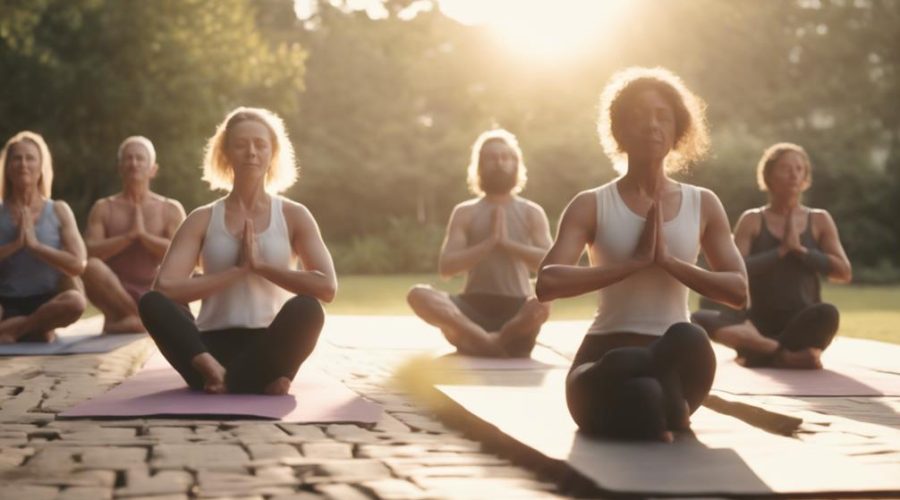What Is the Most Famous Yoga?
Hatha Yoga is perhaps the most renowned form of yoga globally. It's an ancient system that emphasizes balance through a combination of physical postures and breathing exercises. This style caters to your modern wellness aims, improving your flexibility, strength, and inner harmony. Hatha Yoga seamlessly blends the wisdom of the ages with the needs of today, making it a compelling choice for beginners and seasoned practitioners alike. Starting your wellness journey with Hatha Yoga has its perks, but there's a world of different yoga styles awaiting your discovery as you continue on your path.
Key Takeaways
- The most famous yoga style globally is Hatha Yoga, known for its balance and harmony.
- Vinyasa Yoga is popular for its rhythmic, meditative movements and flow.
- Bikram Yoga, performed in heated rooms, is famous for its detoxification benefits.
- Ashtanga Yoga is renowned for its synchronized breath and progressive postures.
- Restorative Yoga is widely recognized for its focus on relaxation and healing.
Understanding Yoga's Global Popularity
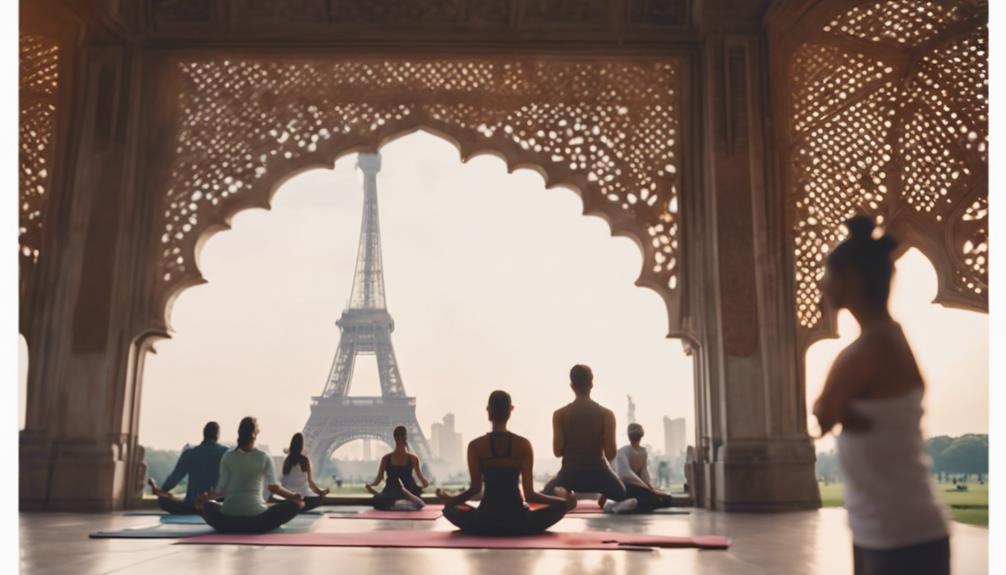
While you may see yoga as merely a trendy fitness routine, it's important to understand that its global popularity stems from its profound ability to harmonize the body, mind, and spirit. This holistic approach to wellbeing transcends borders and cultures, creating global yoga trends that are as diverse as they're compelling.
The commercialization of yoga has certainly played a part in its widespread appeal. Yoga studios, retreats, and digital platforms have made it accessible and attractive to a wide audience. Yet, it's not just about the validation of a centuries-old practice. There's an underlying appreciation for the transformative power of yoga that fuels its popularity.
You've probably noticed that yoga is more than just a series of poses. It's an invitation to explore the depths of your being, to cultivate mindfulness, and to foster a sense of inner peace. This profound journey of self-discovery resonates with a global audience seeking balance in an increasingly chaotic world.
In essence, yoga's global popularity is a confirmation of its enduring relevance and adaptability. It thrives in the intersection of tradition and innovation, offering a pathway to holistic wellbeing that's as timeless as it's contemporary.
A Brief History of Yoga
You'll find that yoga's history is as rich and diverse as its many practices.
It's important to understand these ancient roots to fully appreciate the evolution of yoga.
From its spiritual beginnings in ancient India to its modern, global popularity, the journey of yoga is a fascinating one.
Yoga's Ancient Roots
Exploring yoga's ancient roots, one must grasp that this discipline, highly regarded today for its physical and mental advantages, began in India over 5,000 years ago. With Yogic Philosophy and Meditation Techniques at its core, it was a way to achieve harmony between the heart and soul.
Diving deeper, we find four key elements that have shaped yoga through the ages:
- The Vedas: Ancient Indian scriptures where yoga was first mentioned.
- Upanishads: Philosophical texts illustrating the core concepts of yogic philosophy.
- Bhagavad Gita: Here, yoga is outlined as a practical approach to self-realization.
- Yoga Sutras of Patanjali: This defined the 8-fold path of yoga, forming the foundation of its practice today.
This rich history has molded the yoga that's cherished and practiced widely today.
Evolution of Yoga
Over centuries, yoga has evolved from a niche spiritual practice in ancient India to a globally recognized form of exercise and relaxation, shaping and reshaping its philosophies and forms along the way.
Initially, yoga's spiritual aspects were paramount, focusing on achieving inner peace and enlightenment. As yoga moved into the Western world, it integrated more physical postures, evolving into a holistic practice intertwining body, mind, and spirit.
Concurrently, yoga and meditation became interconnected, amplifying the benefits of each. Today, yoga continues to progress, blending ancient wisdom with modern needs, and allowing practitioners to customize their experience.
Embrace this evolution, as it allows you to explore, adapt, and curate a practice that resonates deeply with your unique journey.
Overview of Different Yoga Styles
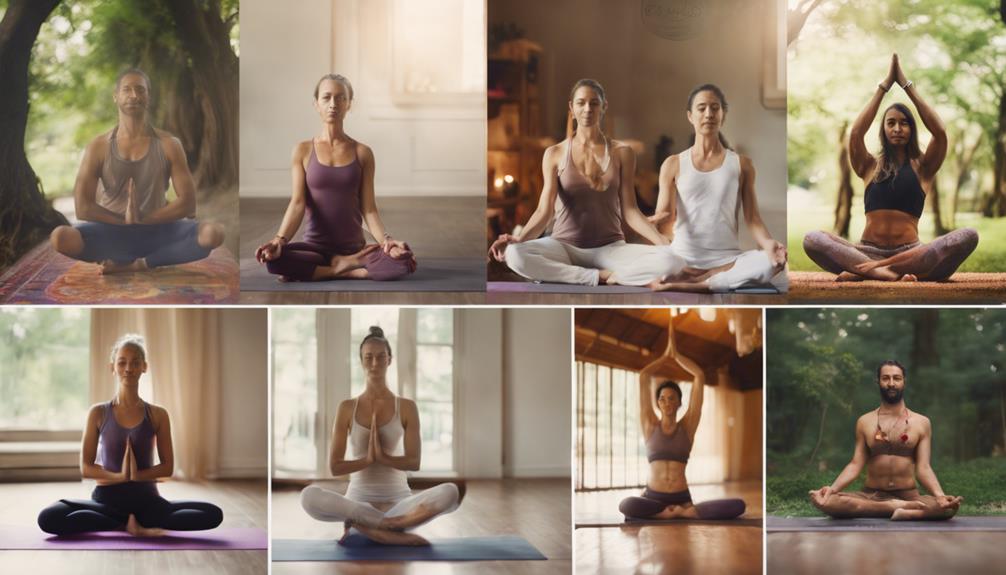
Diving into the world of yoga, you'll encounter a myriad of styles, each with its unique focus and benefits. As yoga fashion trends evolve and celebrity yoga advocates endorse their preferred practices, a few styles have risen in popularity.
- Vinyasa Yoga. This fluid, dynamic style synchronizes movement with breath, providing a rhythmic and meditative experience. Celebrity advocates like Jennifer Aniston have popularized this style, citing its ability to boost flexibility and strength.
- Bikram Yoga. Known for its heated room setting, this style has 26 poses and two breathing exercises. Heavy sweating is part of the process, intended to detoxify the body. Lady Gaga is a known fan.
- Ashtanga Yoga. This rigorous and structured practice involves synchronizing breath with a progressive series of postures. It's loved by the likes of Gwyneth Paltrow for its physically demanding nature.
- Restorative Yoga. This gentle, slow-paced style focuses on relaxation and healing, using props like bolsters and blankets to support the body. It's become a favourite among those seeking stress relief, including stars like Julia Roberts.
The Rise of Hatha Yoga
Let's turn our attention to the rise of Hatha Yoga.
You're about to journey through its ancient roots, explore the health benefits it promises, and get a sense of the modern Hatha Yoga practice.
Ready yourself for a fascinating exploration of this increasingly popular yoga style.
Hatha Yoga's Ancient Roots
Tracing back thousands of years, you'll find the origins of Hatha Yoga deeply rooted in ancient Indian philosophy and spirituality. It's a fascinating journey into Hatha symbolism and principles that underpin this transformative practice.
- The term 'Hatha' itself is derived from 'ha' symbolizing the sun and 'tha' symbolizing the moon. This reflects the balance and harmony Hatha principles aim to achieve, between mind and body, strength and flexibility, masculinity and femininity.
- Hatha Yoga's postures, or asanas, and controlled breathing exercises, or pranayama, are designed to purify and prepare the body for meditation, aligning with ancient spiritual pursuits.
- It integrates the concept of chakras, energy centers within the body, promoting the most favorable flow of life force or 'prana'.
- Lastly, Hatha Yoga emphasizes self-discipline, mindfulness, and inner peace, aligning with traditional yogic philosophy.
Embrace Hatha Yoga's ancient roots to truly appreciate its modern applications.
Health Benefits of Hatha
The rise of Hatha Yoga in the modern world has brought a plethora of health benefits to the forefront, transforming not just the physical but also the mental wellbeing of its practitioners. Hatha's restorative power is truly revolutionary, fostering enhanced flexibility, strength, and balance. Additionally, it promotes cardiovascular and respiratory health, aiding in the prevention of lifestyle diseases.
But it's not just about the body. Hatha is equally potent in balancing dualities, harmonizing the mind and spirit. It bolsters mental clarity, reduces stress, and cultivates mindfulness. Regular practice can lead to improved concentration, emotional stability, and a serene outlook on life. Embrace Hatha Yoga and open the door to holistic health, proving that innovation isn't always about looking forward, but also rediscovering the wisdom of the past.
Modern Hatha Yoga Practice
Understanding the popularity of Hatha Yoga in today's society requires a look at its modern practice, which has evolved dramatically from its ancient roots. This transformation of Hatha Yoga's philosophical underpinnings into a contemporary and accessible practice is a reflection of its enduring appeal.
- The emphasis on physical postures, or asanas, which promote flexibility, strength and balance.
- The integration of breathing exercises, or pranayama, which aid in stress reduction and mental clarity.
- The fusion of meditative practices that seek to cultivate mindfulness and inner peace.
- The Contemporary Hatha controversies, arising mainly from commercialization and lack of authenticity, have sparked debates about its true essence.
These elements combined have catapulted Hatha Yoga into a worldwide phenomenon, reshaping our understanding of wellness and self-care.
Why Is Vinyasa Yoga so Popular?
With its dynamic flow and rhythmic breathing, Vinyasa Yoga has captured your interest, hasn't it? The popularity of this form of yoga can be attributed to Vinyasa's mental benefits and its accessibility. Unlike other yoga styles, Vinyasa's smooth progressions and continuous movement make the practice engaging, keeping you focused and present.
Vinyasa's mental benefits are profound. Each sequence is designed to help you attain a state of mindfulness. It challenges your mental fortitude, pushing you to remain centered amidst its brisk pace. This practice trains your mind to stay calm, even under pressure, a skill useful beyond the yoga mat and into your daily routine.
Vinyasa's accessibility also adds to its popularity. It's not limited to a yoga studio. You can practice it anywhere, whether it's at home, in a park, or even on vacation. Its flexible nature allows you to adapt the practice to your skill level, making it welcoming for beginners, yet stimulating for seasoned yogis.
The Appeal of Ashtanga Yoga
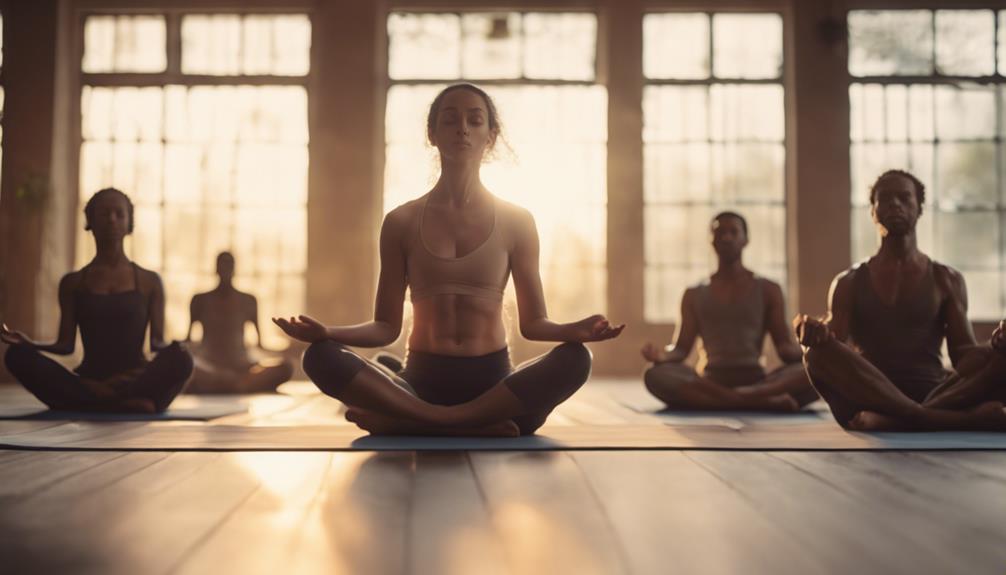
Shifting your attention now to another remarkable form of yoga, let's explore Ashtanga, a practice that's been catching the eye of yogis worldwide due to its unique appeal. Ashtanga's intensity isn't for the faint-hearted. It involves a challenging series of postures that require strength, flexibility, and a focused mind. But, this intensity is part of its allure.
The appeal of Ashtanga yoga lies in several distinct areas:
- Physical Challenge. It's a rigorous practice that pushes your physical boundaries, creating a stronger body and mind.
- Consistency. The sequence of postures stays the same, giving you a chance to measure your progress.
- Mental Focus. It demands concentration, leading to improved mental clarity and mindfulness.
- Celebrity Endorsements. Many celebrities swear by Ashtanga, further boosting its popularity.
You're not just following a trend when you hop onto the Ashtanga train. You're embracing a practice that has proven physical and mental benefits. It's no wonder Ashtanga is gaining traction amongst yoga practitioners and celebrities alike, making it a compelling choice for those seeking a vigorous, consistent, and mindful practice.
Exploring the Popularity of Bikram Yoga
Diving into another popular yoga discipline, let's take a look at Bikram Yoga, which has made a significant splash in the global yoga community with its unique characteristics and benefits. This form of yoga, founded by Bikram Choudhury, incorporates a series of 26 poses and two breathing exercises performed in a heated room. The heat purportedly aids in flexibility and detoxification, providing a challenging yet rewarding experience.
Bikram's popularity has been bolstered by celebrities endorsing Bikram, including Lady Gaga and David Beckham, who've lauded its intense physical challenge and potential health benefits. However, it's not been without controversy. The Bikram controversy involves allegations against Choudhury, which has led to a divide within the community. Despite this, practicing Bikram continues to thrive, largely due to its distinctive, transformative approach to yoga.
Innovation is at the core of Bikram, pushing the boundaries of traditional yoga. It's a compelling blend of physical exertion and mental discipline, making it a standout among yoga disciplines. Its popularity and influence are a proof of its effectiveness, proving that even amidst controversy, a potent and innovative approach to yoga can resonate with the masses.
The Impact of Yoga on Health and Wellness
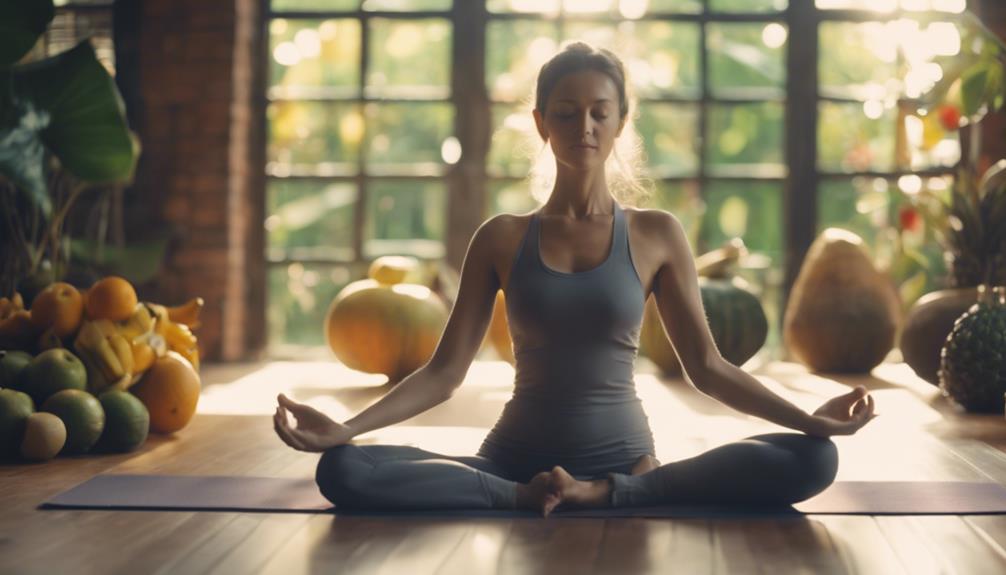
While the unique styles of Bikram and other yoga disciplines capture attention, it's the profound impact on health and wellness that truly solidifies yoga's importance in many people's lives. Integrating yoga into your daily routine can lead to significant improvements in both your physical and mental health.
Let's explore some key benefits.
- Physical Agility: Regular practice enhances strength, flexibility, and balance.
- Stress Reduction: Yoga's psychological effects are remarkable. It reduces stress levels and promotes relaxation, contributing to an improved quality of life.
- Heart Health: Yoga can lower blood pressure and slow the heart rate, beneficial for those with heart disease.
- Weight Management: Regular practice can support your weight management goals while enhancing overall body tone.
As you can see, yoga isn't just about challenging poses or deepening spirituality. It's a holistic approach to wellness, nurturing the mind-body connection. This all-encompassing perspective makes yoga a powerful tool in your health and wellness arsenal. So why wait? Embrace this ancient practice and allow its transformative power to unfold in your life. Remember, it's not about perfection, but the journey towards a healthier, happier you.
Deciphering Your Personal Yoga Style
Determining your personal yoga style can be a transformative journey, allowing you to discover what truly resonates with your individual needs and aspirations. It's not merely about the physical postures, but your connection to them, the energy they ignite within you.
Your quest for a personal yoga style should always start with understanding your physical and emotional state. Do you need a calming routine or an energizing one? Are you looking to build strength or increase flexibility? Once you're clear on these, you can then start crafting personalized routines that cater to your unique needs.
Don't forget the role of yoga accessories in enhancing your practice. They're not just tools, but extensions of your yoga experience. A good quality yoga mat can provide the necessary support and comfort for your body. Blocks and straps can help you achieve proper alignment and deeper stretches, especially if you're still working on your flexibility.

